|
|
A
Close-up View of Two Forget - Me - Nots: (Myosotis stricta and Myosotis
scorpioides) |
|
|
A
Close-up View of Two Forget - Me - Nots: (Myosotis stricta and Myosotis
scorpioides) |
…..
Where Past and Present,
wound in one,
Do make a garland for the
heart:
So sing that other song I
made,
Half-anger’d with my happy
lot,
The day, when in the
chestnut shade
I found the blue
Forget-me-not.
Alfred Lord Tennyson
(Excerpt
from “The Miller’s Daughter”)
Field Forget-Me-Not - Myosotis stricta
I first saw this extraordinary wildflower while walking in the rain in
early May. Perhaps “saw” is not quite accurate, since from
walking height, this very tiny flower is all but invisible. At
best, the diameter of the bloom is a mere 2 to 4 mm! What I did
notice was that a section of the grassy slope had a beautiful blue
tint. On closer inspection, the tiny pink buds and blue flowers
showed great promise, so I pulled up a bunch by the roots and
transported the soggy mess home. Fortunately, with roots immersed
in water, and plenty of sunlight, the plants survived for a week.
As can be seen from the photograph below, the flowers are tiny in
comparison with the rest of the plant.

Sometimes, you have to look hard to see the pink buds amongst the
profusion of stems.

The entire plant is remarkable in its hairiness. The genus name
“Myosotis” derives from the Greek mus
which means “mouse”, and otos
meaning “ear”. This refers to the tiny, hairy leaves, which, if
colour is ignored, do indeed resemble mouse ears (see below)!

The flowers of this species are trumpet shaped, and pale blue with a
yellow throat. There are five petals, and, if you look closely,
five pointed green sepals (modified leaves) beneath the petals.



Readers of my previous articles about wildflowers know that I favour a
black background for macrophotographs. To me, this enhances
contrast and provides less of a distraction. As an experiment, I
replaced my normal black velvet background by a gray one. The
results are shown below. Perhaps the images look more “natural”,
as though they were obtained “in the field”, but I still prefer
black! I greatly admire photographers who shoot wildflowers in
the field, coping with random breezes, and less than ideal lighting
conditions. For me, however, the complete control of most
variables afforded by table-top macrophotography, is of paramount
importance.



The image below, taken under the microscope, reveals a bud about to
bloom, framed by two of its five sepals.

After blooming, the tiny flowers are sometimes dislodged from the
sepals, leaving a tiny hairy cup-shaped structure.

Higher magnification reveals just how hairy these sepals are!

Most of the hairs are fairly straight, but some are distinctly hooked,
as can be seen below.

Extreme magnification shows that the hairs are covered with tiny bumps.

Although Field Forget-Me-Not is almost too small to be appreciated with
the naked-eye, its beautiful blue petals, and delicate pink buds make
it one of my favourite wildflowers.
True Forget-Me-Not - Myosotis scorpioides

This striking wildflower must be everyone’s favourite! Originally
introduced from Europe, this plant has become naturalized through much
of North America. Unlike the prevous species, True
Forget-Me-Not requires considerable moisture, and is usually found
along the shores of lakes and the edges of streams. This was true
of the plants photographed for this article which were growing in the
location shown in the image below. There is a river behind the
trees, and the plants were situated in the shade half-way down the
embankment, making it difficult (and dangerous) to obtain them.

The species name scorpioides
refers to the fact that when the plant emerges from the ground, the
stem is coiled and resembles a scorpion tail. This is also true
of Field Forget-Me-Not and if you look closely at the second image in
the article, several of these “tails” are visible.
Forget-Me-Nots are members of the Borage Family whose offspring are
universally hairy. The buds of the “True” variety, although
larger, are almost indistinguishable from the “Field” variety.

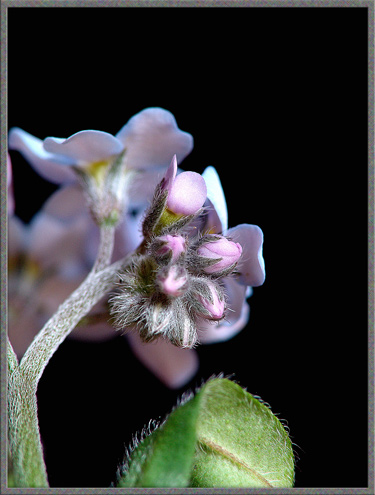
In the higher magnification image that follows, the sepals that cup
each bud are visible.
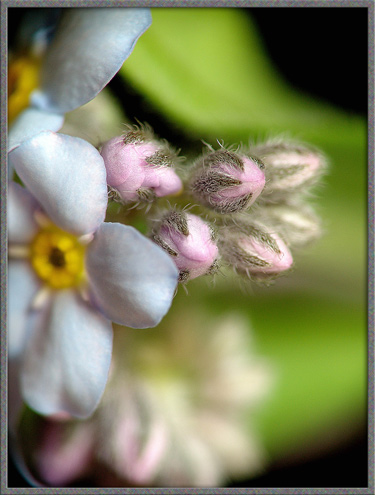
The flowers are pale blue, with yellow centres. Pink spots are
often found on mature petals.
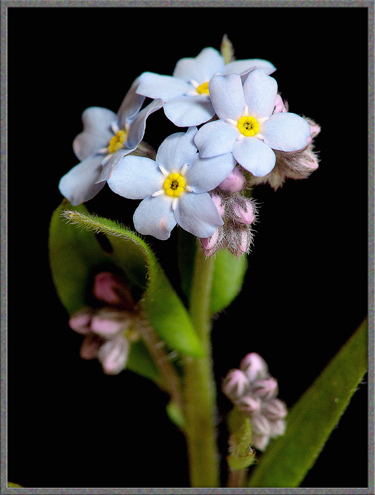
From the back, it can be seen that each bloom grows on a short stalk,
which may, or may not be joined to others at one point. The five
petals form a narrow tube at the base which flares abruptly to form the
trumpet-like front called the limb.
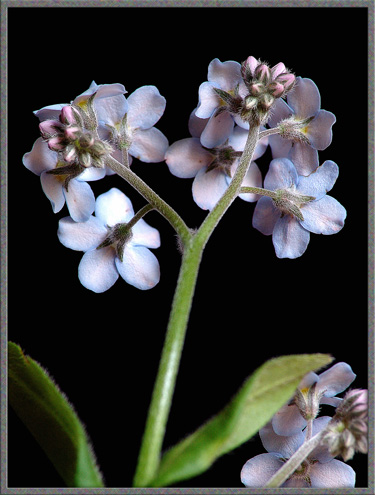
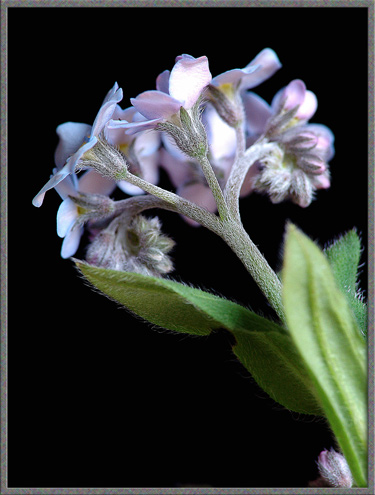
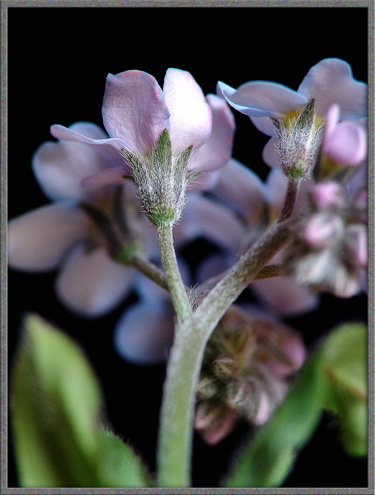
A single flower is from 6 to 8 mm in diameter, and when newly opened is
a beautiful sky-blue colour. Patches of bright yellow pollen are
often found on the petals (upper right corner).
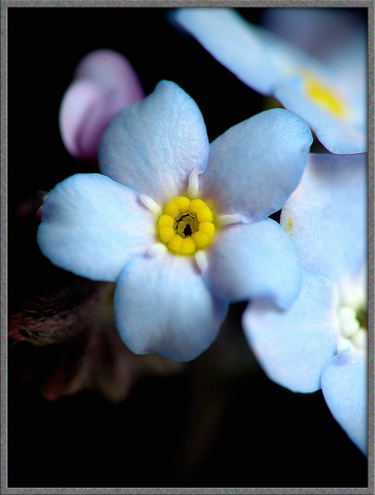
The blooms last a considerable time, although they do tend to fade
slightly with age.
Each flower has five petals, each with an unusual white appendage along
the inner edge. At the centre there are five bright yellow
bi-lobed structures called fornices.
The five anthers can be seen just below the fornice ring. (Each
of the filaments holding an anther is fused to one of the petals within
the tubular part of the flower.) There is a single pistil
attached at its base to the ovary.
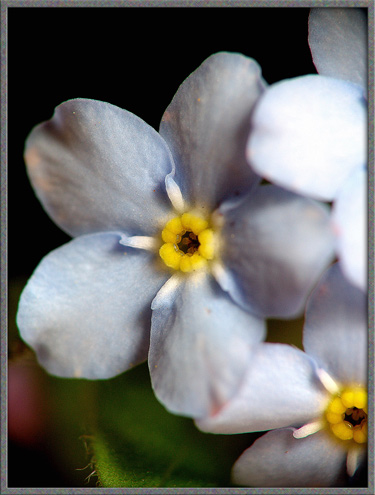
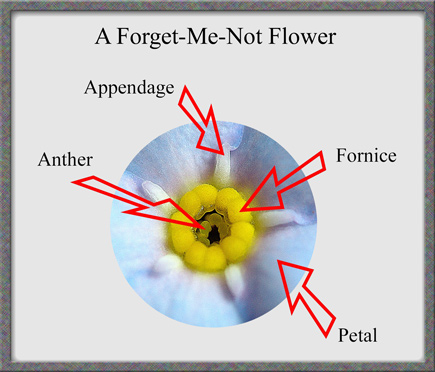
Underneath the petals are the five green sepals (modified leaves) that
form the calyx of the plant. (Isn’t the terminology of botany
wonderful!) The hairy nature of a single sepal is shown in the
photomicrograph below.
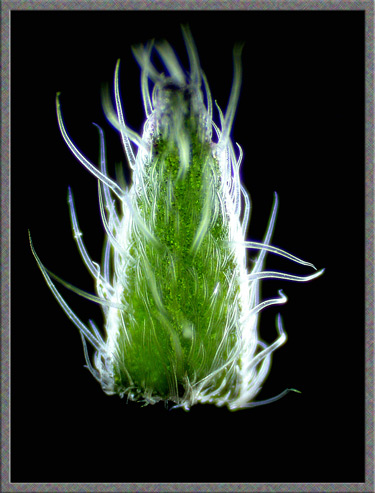
Higher magnification reveals more details.
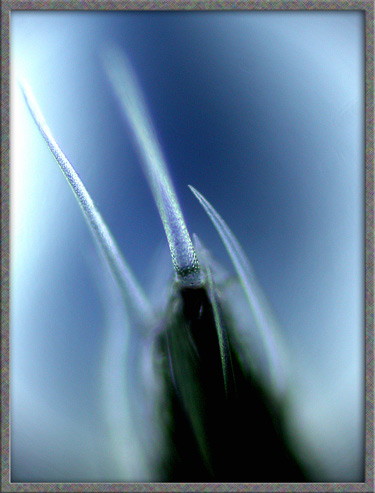
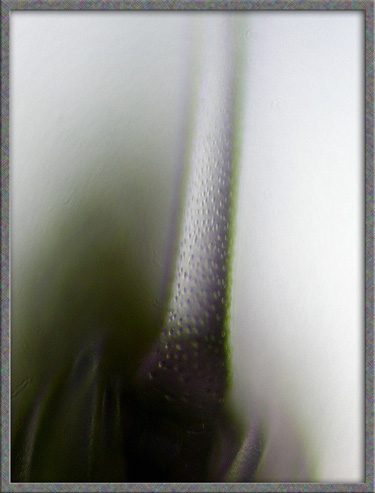
The following image shows the five anthers, each with a pale green
filament which is fused to the interior surface of a petal. The
petals have been removed, and the dark triangular shapes are the tips
of green sepals.
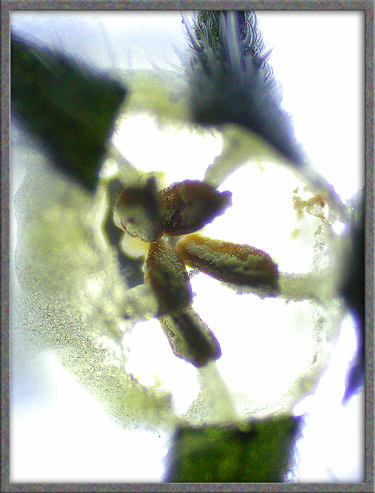
The final image shows a view from inside the flower facing out.
Three anthers can be seen as well as the (out of focus) ring of yellow
fornices.
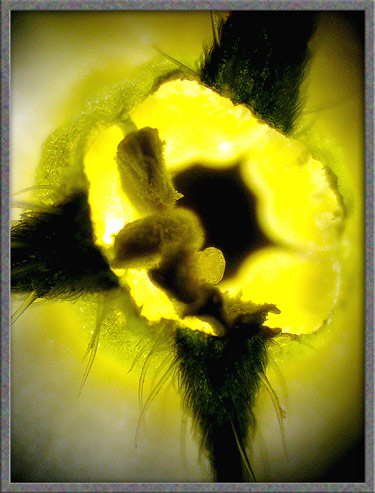
The comparison of various members of the same wildflower family is an
interesting part of the hobby. Although the two species studied
here are quite similar, others may be remarkably different! In an
earlier article I presented a very different looking member of
the Borage family, “Viper’s Bugloss”
If you are interested in having a look, you can find it here.
Photographic
Equipment
The photographs in the article were
taken with an eight megapixel Sony CyberShot DSC-F 828 equipped with
achromatic close-up lenses (Nikon 5T, 6T, Sony VCL-M3358, and shorter
focal length achromat) used singly or in combination. The lenses screw
into the 58 mm filter threads of the camera lens. (These produce
a magnification of from 0.5X to 10X for a 4x6 inch image.) Still
higher magnifications were obtained by using a macro coupler (which has
two male threads) to attach a reversed
50 mm focal length f 1.4 Olympus SLR lens to the F 828. (The
magnification here is about 14X for a 4x6 inch image.) The
photomicrographs were taken with a Leitz SM-Pol microscope (using dark
ground and polarizing condensers), and the Coolpix 4500.
References
The following references have been
found to be valuable in the identification of wildflowers, and they are
also a good source of information about them.
Published in the June
2005 edition of Micscape.
Please report any Web problems or
offer general comments to the Micscape
Editor.
Micscape is the on-line monthly magazine
of the Microscopy UK web
site at Microscopy-UK
© Onview.net Ltd, Microscopy-UK, and all contributors 1995 onwards. All rights reserved. Main site is at www.microscopy-uk.org.uk with full mirror at www.microscopy-uk.net .